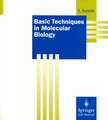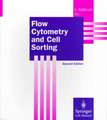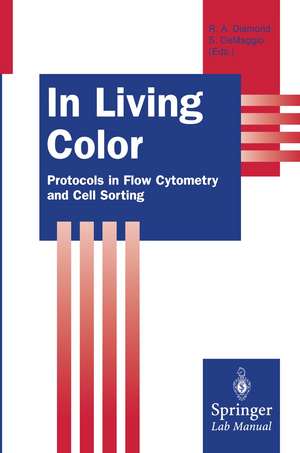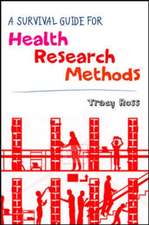In Living Color: Protocols in Flow Cytometry and Cell Sorting: Springer Lab Manuals
Editat de Rochelle A. Diamond, Susan DeMaggioen Limba Engleză Paperback – 5 oct 2013
Din seria Springer Lab Manuals
-
 Preț: 385.84 lei
Preț: 385.84 lei -
 Preț: 362.59 lei
Preț: 362.59 lei - 18%
 Preț: 973.69 lei
Preț: 973.69 lei - 15%
 Preț: 695.85 lei
Preț: 695.85 lei - 18%
 Preț: 997.40 lei
Preț: 997.40 lei -
 Preț: 385.84 lei
Preț: 385.84 lei -
 Preț: 382.18 lei
Preț: 382.18 lei - 24%
 Preț: 1045.10 lei
Preț: 1045.10 lei - 15%
 Preț: 641.20 lei
Preț: 641.20 lei - 18%
 Preț: 939.33 lei
Preț: 939.33 lei -
 Preț: 381.43 lei
Preț: 381.43 lei - 15%
 Preț: 637.59 lei
Preț: 637.59 lei - 15%
 Preț: 639.25 lei
Preț: 639.25 lei -
 Preț: 376.68 lei
Preț: 376.68 lei - 18%
 Preț: 1822.40 lei
Preț: 1822.40 lei - 18%
 Preț: 953.82 lei
Preț: 953.82 lei - 15%
 Preț: 645.14 lei
Preț: 645.14 lei - 15%
 Preț: 689.93 lei
Preț: 689.93 lei - 19%
 Preț: 588.70 lei
Preț: 588.70 lei - 5%
 Preț: 727.44 lei
Preț: 727.44 lei - 18%
 Preț: 1225.31 lei
Preț: 1225.31 lei - 15%
 Preț: 657.39 lei
Preț: 657.39 lei - 18%
 Preț: 949.73 lei
Preț: 949.73 lei -
 Preț: 386.99 lei
Preț: 386.99 lei - 15%
 Preț: 657.25 lei
Preț: 657.25 lei - 19%
 Preț: 555.63 lei
Preț: 555.63 lei -
 Preț: 380.63 lei
Preț: 380.63 lei - 18%
 Preț: 1226.11 lei
Preț: 1226.11 lei - 15%
 Preț: 649.22 lei
Preț: 649.22 lei - 15%
 Preț: 632.55 lei
Preț: 632.55 lei - 19%
 Preț: 584.77 lei
Preț: 584.77 lei - 15%
 Preț: 639.41 lei
Preț: 639.41 lei - 15%
 Preț: 644.82 lei
Preț: 644.82 lei -
 Preț: 390.25 lei
Preț: 390.25 lei - 18%
 Preț: 781.31 lei
Preț: 781.31 lei - 15%
 Preț: 644.63 lei
Preț: 644.63 lei -
 Preț: 382.36 lei
Preț: 382.36 lei -
 Preț: 363.12 lei
Preț: 363.12 lei - 18%
 Preț: 961.23 lei
Preț: 961.23 lei -
 Preț: 416.29 lei
Preț: 416.29 lei - 18%
 Preț: 783.35 lei
Preț: 783.35 lei - 18%
 Preț: 791.88 lei
Preț: 791.88 lei - 15%
 Preț: 675.22 lei
Preț: 675.22 lei - 23%
 Preț: 1311.58 lei
Preț: 1311.58 lei -
 Preț: 381.43 lei
Preț: 381.43 lei
Preț: 821.59 lei
Preț vechi: 1067.01 lei
-23% Nou
Puncte Express: 1232
Preț estimativ în valută:
157.23€ • 163.55$ • 129.80£
157.23€ • 163.55$ • 129.80£
Carte tipărită la comandă
Livrare economică 11-17 aprilie
Preluare comenzi: 021 569.72.76
Specificații
ISBN-13: 9783642629785
ISBN-10: 3642629784
Pagini: 864
Ilustrații: XXV, 800 p. 171 illus., 13 illus. in color.
Dimensiuni: 155 x 235 x 45 mm
Ediția:Softcover reprint of the original 1st ed. 2000
Editura: Springer Berlin, Heidelberg
Colecția Springer
Seria Springer Lab Manuals
Locul publicării:Berlin, Heidelberg, Germany
ISBN-10: 3642629784
Pagini: 864
Ilustrații: XXV, 800 p. 171 illus., 13 illus. in color.
Dimensiuni: 155 x 235 x 45 mm
Ediția:Softcover reprint of the original 1st ed. 2000
Editura: Springer Berlin, Heidelberg
Colecția Springer
Seria Springer Lab Manuals
Locul publicării:Berlin, Heidelberg, Germany
Public țintă
ResearchCuprins
Section 1.- A Palette of Living Colors.- The Colorful History of Flow Cytometry.- Section 2.- Getting Started.- 1 How the FACSCalibur and FACS Vantage Work and Why It Matters.- 2 How Flow Cytometers Work — and Don’t Work.- 3 Flow Cytometry Standard (FCS) Data File Format.- 4 Options for Data Display.- 5 Guidelines to Improve Flow Cytometry Data Display and Interpretation.- 6 Data Management and Storage.- 7 Coloring up: A Guide to Spectral Compensation.- 8 Quality Control Guidelines for Research Flow Cytometry.- Section 3.- Sample Preparation and Cell Surface Staining.- 1 Cell Preparation and Enrichment for FCM Analysis and Cell Sorting.- 2 The Basics of Staining for Cell Surface Proteins.- 3 Phenotypic Analysis Using Five-Colour Immunofluorescence and Flow Cytometry.- 4 Detection of Cell Surface Antigens Using Antibody- Conjugated Fluorospheres and Flow Cytometry.- 5 Gel Microdrop Encapsulation for the Frugal Investigator.- Section 4.- Reporter Genes and Cell Trackers.- 1 Flow Cytometric Analysis of GFP Expression in Mammalian Cells.- 2 FACS-Gal: Flow Cytometric Assay of ß-galactosidase in Viable Cells.- 3 Utilization of a Bicistronic Expression Vector for Analysis of Cell Cycle Kinetics of Cytotoxic and Growth-arrest Genes.- 4 NGFR as a Selectable Cell Surface Reporter.- 5 Assessment of Cell Migration in vivo Using the Fluorescent Tracking Dye PKH26 and Flow Cytometry.- 6 In vivo Biotinylation for Cell Tracking and Survival/Lifespan Measurements.- 7 Enrichment and Selection for Reporter Gene Expression with MACSelect.- 8 Use of PKH Membrane Intercalating Dyes to Monitor Cell Trafficking and Function.- Section 5.- Flow Cytometry of Nucleic Acids.- 1 RNA Content Determination Using Pyronin Y.- 2 DNA Content Determination.- 3 Dead Cell Discrimination.- 4 Detecting Apoptosis.- 5 Chromosome Preparation - Polyamine Method.- 6 ‘D-Flowering’ - The Flow Cytometry of Plant DNA.- 7 Flow Cytometry Analysis of Marine Picoplankton.- 8 Yeast DNA Flow Cytometry.- Section 6.- Intracellular Physiological and Antibody Probes.- 1 Calcium Flux Protocol: INDO-1 Stained Thymocytes.- 2 Intracellular pH Measured by ADB.- 3 Measuring Intracellular pH Using SNARF-1.- 4 FACS Analysis of Ph and Apoptosis.- 5 Measurement of Ligand Acidification Kinetics for Adherent and Non-Adherent Cells.- 6 Intracellular Antigen Detection by Flow Cytometry.- 7 Flow Cytometric Measurement of Nuclear Matrix Proteins.- 8 CellProbe Flow Cytoenzymology.- 9 Intracellular Cytokine Detection.- Section 7.- Electronic Cell Sorting.- 1 Creating Standard and Reproducible Sorting Conditions.- 2 Sterilization for Sorting.- 3 High Speed Cell Sorting Using the Cytomation CICERO® and MoFlo® Systems.- 4 Purification of Mouse Fetal Liver Hematopoietic Stem Cells.- 5 Methods for Preparing Sorted Cells as Monolayer Specimens.- 6 Fluorescent in Situ Hybridization Analysis on Cells Sorted onto Slides.- Section 8.- Core Facilities.- 1 Core Facility Management.- 2 Funding for Core Facilities.- 3 Biosafety in the Flow Cytometry Laboratory.- Section 9.- Unlocking the Spectrum of Possibilities.- Appendices.
Caracteristici
Flow cytometry and cell sorting are becoming increasingly important in biological research Step-by-step approach to the methodology for measuring various cellular attributes Includes supplementary material: sn.pub/extras











